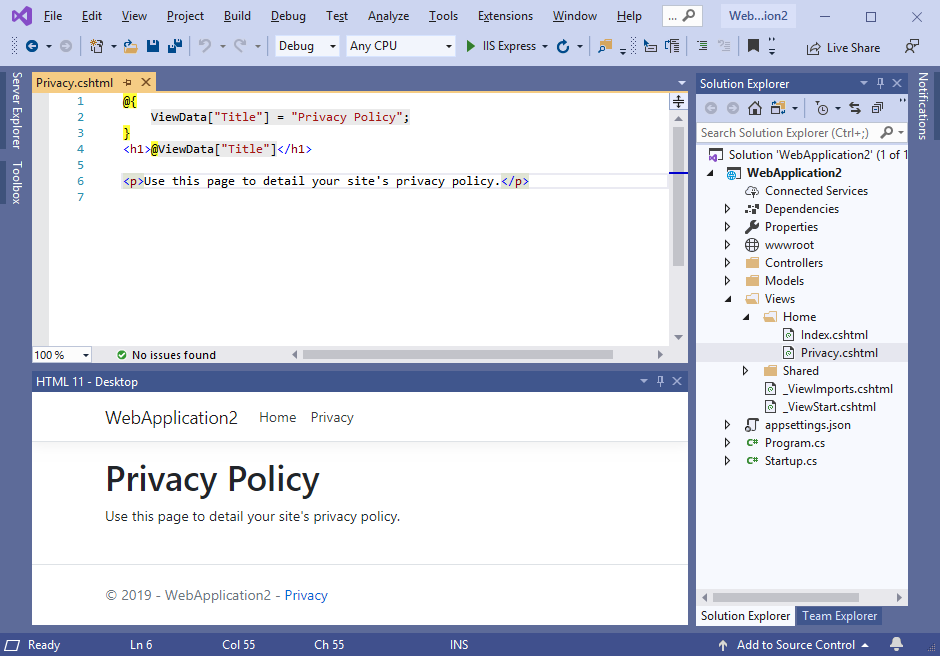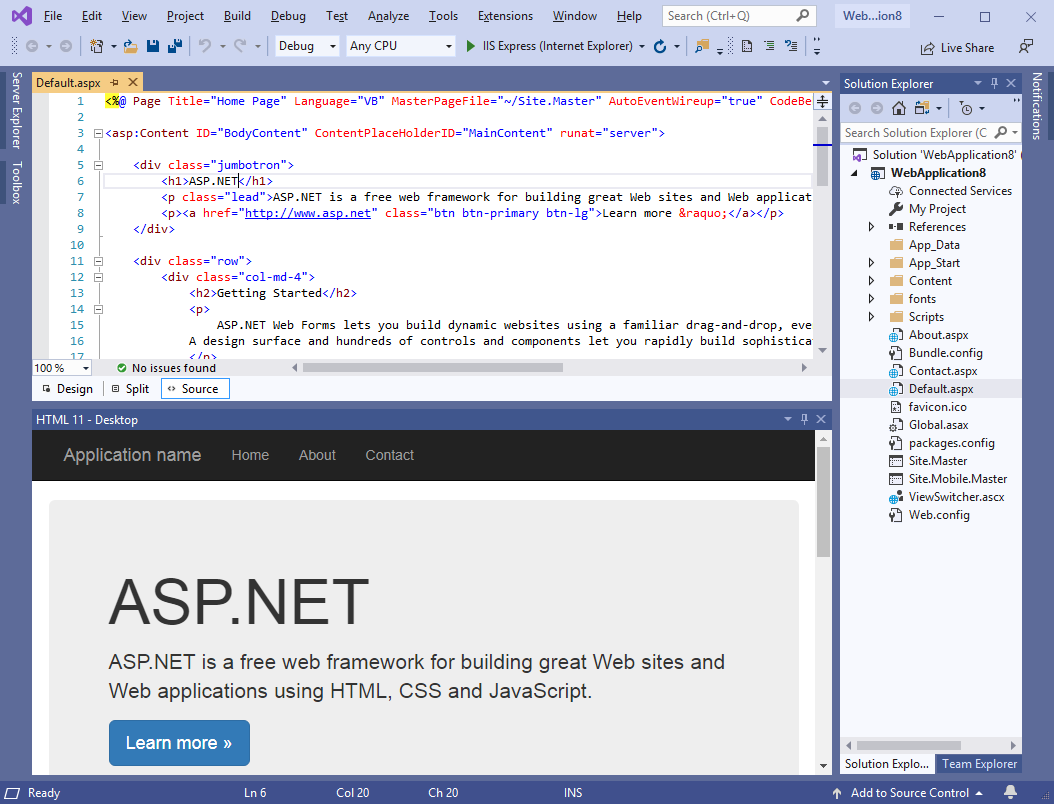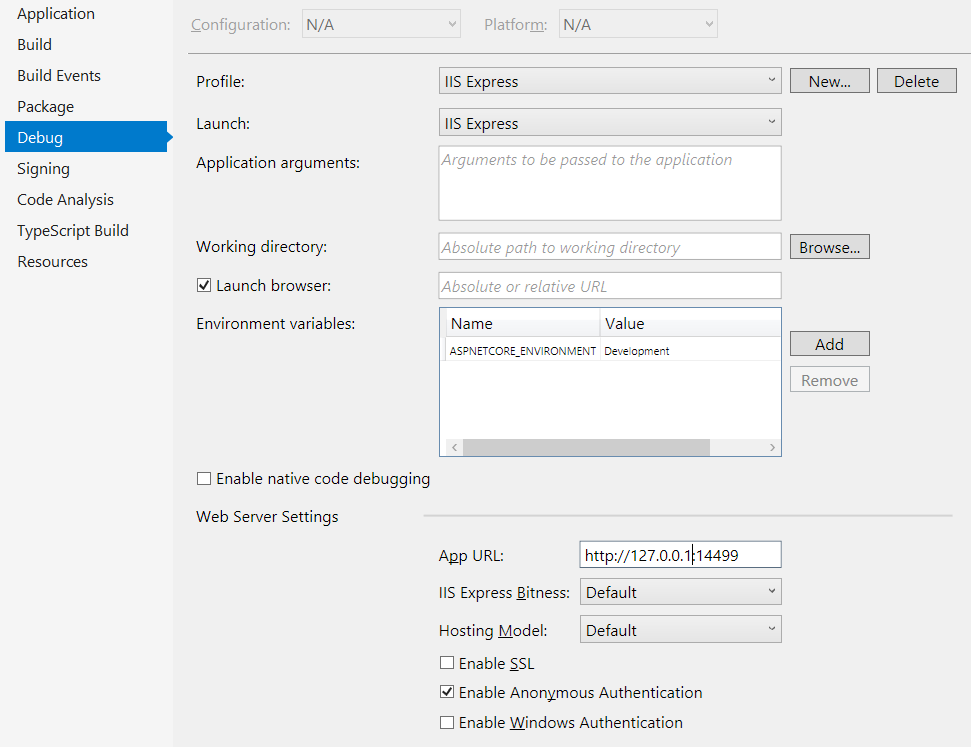 HTML 11
HTML 11
HTML 11 extension provides tool windows in Visual Studio 2022/2019/2017 showing preview of static and dynamic web pages you are currently editing, on desktop and mobile devices.
Static .html pages

The preview is updated as you type. When you change a .css or a .js file referenced in the HTML document, the preview is updated after you save the referenced file.
Razor .cshtml pages in ASP.NET Core 2.1/3.0 web application

MVC view .cshtml pages in ASP.NET Core 2.1/3.0 web application

.razor pages in Blazor app

Web Forms .aspx pages in ASP.NET web application

MVC view .cshtml/.vbhtml pages in ASP.NET web application

While the web application server is running in IIS Express, the preview is updated when you save a document. When the server is stopped, the preview is no longer updated and a red border is displayed around the preview area.
Getting started
To initially open HTML 11 tool windows, select Desktop preview or Mobile preview in the main HTML11 menu:

You can position opened tool windows alongside the HTML editor or outside the main Visual Studio window, e.g. on a second monitor.
HTML is rendered using Chromium Embedded Framework v92.
The Reload command resets and reloads all opened previews.
How it works
Static .html pages and associated resources (images, styles, scripts) are loaded by the embedded Chromium browser directly from the disk. For the live preview, page content is provided from a memory buffer.
To show preview for dynamic pages, you need to start the web application (usually pressing Ctrl + F5). HTML 11 finds App/Project URL in web server settings (usually http://localhost:[random-port]), adds the file path to it and opens the preview. When you change and save a page, Visual Studio recompiles it on save, updates the application on the fly, HTML 11 updates the preview and you see the updated page.
Troubleshooting
If a page preview is not displayed, you can enable diagnostics in Options:

And then in the Output window General page you can look for additional information:

Redirection
If you use custom routing in your web application, you may need to additionally configure HTML 11 to support a different URL scheme.
For example, if you add a culture prefix to your pages in the controller like http://localhost:59999/en/Home/Tourists and open Tourists.cshtml for editing in Visual Studio, HTML 11 will try to connect to http://localhost:59999/Home/Tourists page and fail.
To support this configuration, open Project options from the main HTML 11 menu and add a redirection rule with Pattern=.+ and Target=en/$_:

Pattern and Target use .NET regular expressions syntax and operate on the path part of the URL, in the example above it is Home/Tourists.
Project options are separate for each Visual Studio project and the dialog opens relative to the current active Visual Studio document. It is best to first open the page you want to adjust and then select the Project options menu command.
The Stop processing option in a redirection rule means that if the rule matches, no further rules will be processed.
You can disable a dynamic page preview setting Target to :: and you can override the project url settting Target to an absolute url.
Live preview
By default, for static pages the preview is updated as you type. If frequent changes distract you, you can disable it and the preview will be updated only when you save the file:

Chrome dev tools
Developer tools menu command opens the standard Chromium developer tools window:

Mobile preview
In HTML 11 options you can select a mobile device for preview:

A mobile device is simulated with Chromium DevTools Device Mode.
Open on Android emulator
Open on Android emulator menu command opens the current page on a running Android emulator:

To run an Android emulator, download and install Android Studio. Start Android Studio, select Tools - AVD Manager, Create Virtual Device and Launch it.
Once an AVD image is created, you can quickly start the emulator without opening Android Studio using the following command file:
set ANDROID_SDK_ROOT=%LOCALAPPDATA%\Android\Sdk %ANDROID_SDK_ROOT%\emulator\emulator.exe -avd Pixel_2_API_29To show available AVD names:
set ANDROID_SDK_ROOT=%LOCALAPPDATA%\Android\Sdk %ANDROID_SDK_ROOT%\emulator\emulator.exe -list-avdsTo communicate with the emulator, HTML 11 uses the Android Debug Bridge utility located at:
%LOCALAPPDATA%\Android\Sdk\platform-tools\adb.exe
For dynamic web pages, by default IIS Express listens on localhost, Android emulator accesses the host network at 127.0.0.1 and HTML 11 acts as an HTML proxy between them. To allow direct communication and make Blazor apps work, set App URL host to 127.0.0.1 in Web Server Settings for your site:


The preview is updated when you Save All documents.
Business License
Business licenses are paid by the number of Windows workstations ("Seats") where HTML 11 is installed. Any employee of your company can use HTML 11 on these workstations. The number of seats is the number of installations allowed.
HTML 11 Business license for 1 workstation costs $79/year - Buy now.
Personal License
The personal license allows you to use HTML 11 on any number of computers or electronic devices, but you may not permit other individuals to use your license. The personal license must be purchased with personal funds and cannot be reimbursed by a company or organization.
HTML 11 Personal license costs $39/year - Buy now.
Download
HTML 11 v2.0.0 - August 19, 2021. Download 30-day trial
Copyright 2008 - 2024 Vlasov Studio (Best in class Visual Studio extensions and tools)